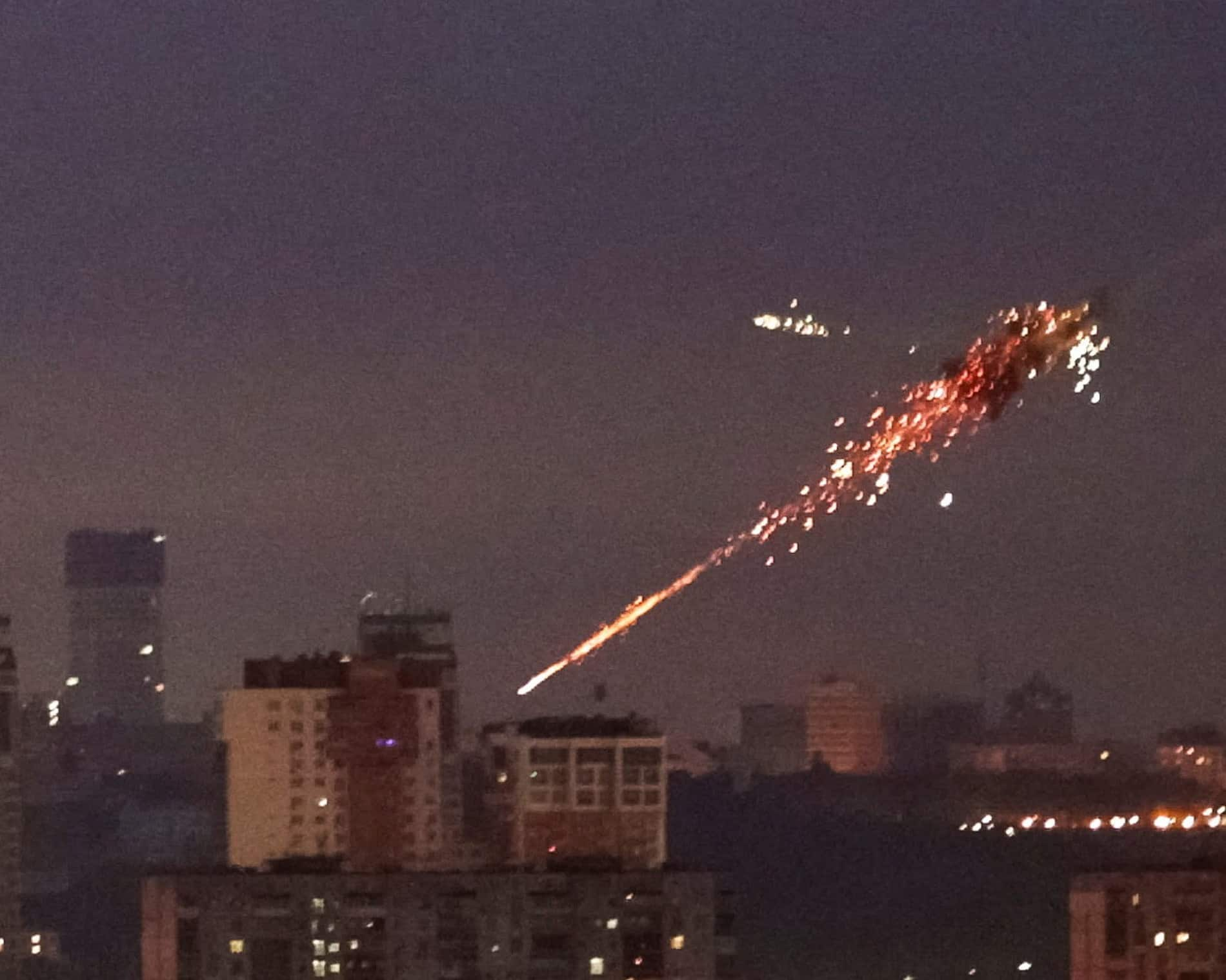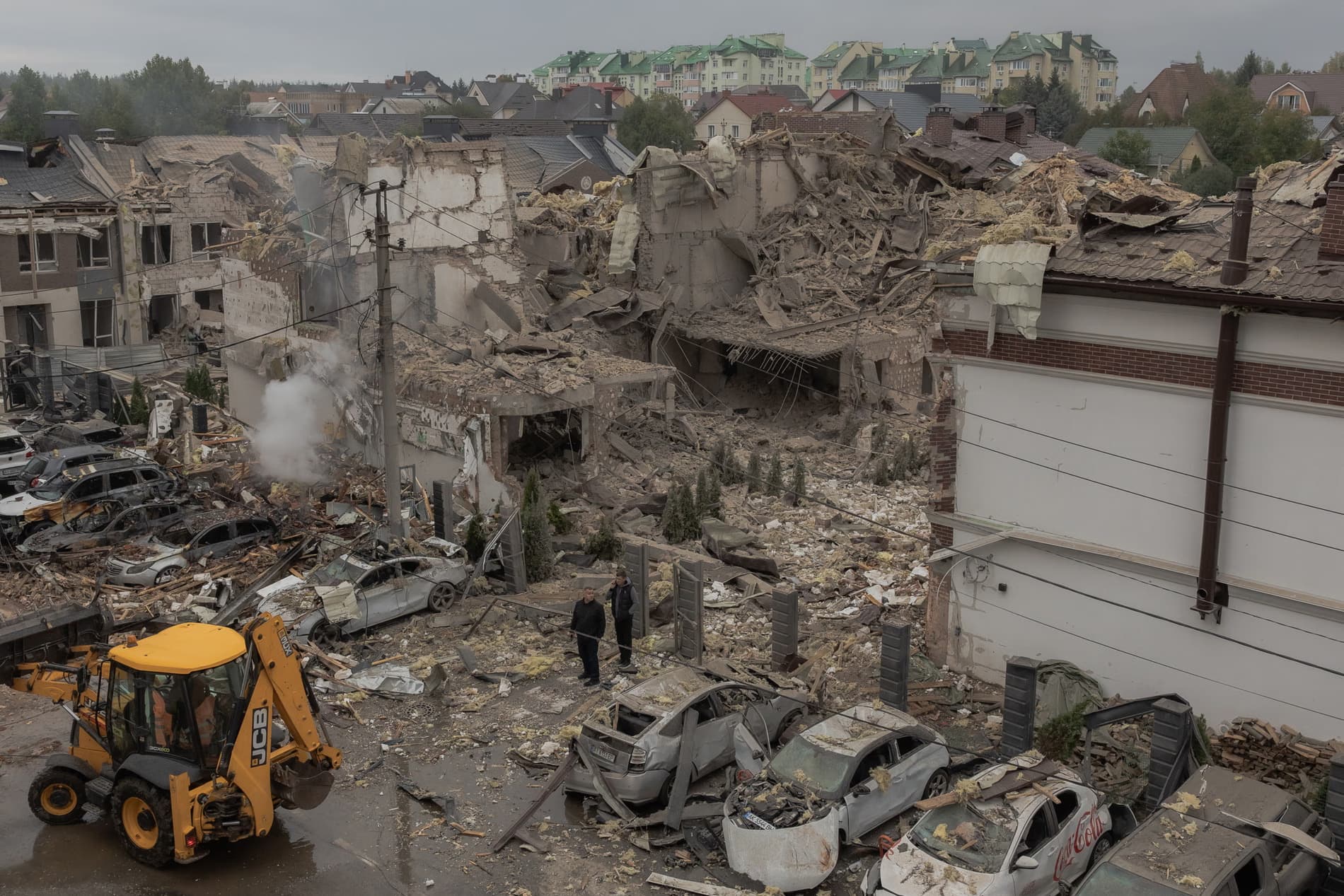



Kyiv woke up to chaos early Sunday as waves of drones and missiles slammed into the Ukrainian capital. Independent monitors, cited by Reuters, Sky News, and The Kyiv Independent, called it one of the heaviest bombardments since Russia’s full-scale invasion began in February 2022.
At least four people, including a 12-year-old girl, were killed, according to Ukrainian officials. Initially, three deaths were confirmed, but the toll was later raised as rescue teams found another body under the rubble. Ten more people were injured in Kyiv, while drone strikes across Zaporizhzhia left 16 wounded, including three children.
 An missile in the sky over Kyiv amid Russia's attack on Ukraine. Photograph: Vladyslav Sodel/Reuters
An missile in the sky over Kyiv amid Russia's attack on Ukraine. Photograph: Vladyslav Sodel/Reuters
Ukraine’s foreign minister Andrii Sybiha said hundreds of drones and missiles were fired overnight. Ukraine’s air force said in an update that Russia fired a total of 595 exploding drones and decoys and 48 missiles. Of those, air defences shot down or jammed 566 drones and 45 missiles.
Russia’s justification: 'Precision strikes' on military sites
Moscow admitted to the assault, claiming its forces hit Ukrainian defence industry sites and military airfields with “high-precision, long-range” weapons.
Kyiv, however, said civilian infrastructure was deliberately targeted. A rubber factory and apartment blocks were among the damaged sites. Zelenskyy accused Russia of using the UN general assembly week to “show its real position to the world, continuing terror and war.”
 Men stand at the site of heavily damaged residential buildings after a Russian air attack on the outskirts of Kyiv. Photograph: Roman Pilipey/AFP/Getty Images
Men stand at the site of heavily damaged residential buildings after a Russian air attack on the outskirts of Kyiv. Photograph: Roman Pilipey/AFP/Getty Images
Poland scrambles jets, NATO’s eastern flank on alert
Poland scrambled fighter jets and placed air defences on high alert as Russian strikes intensified near its border. According to Reuters, Polish military temporarily closed airspace over Lublin and Rzeszow, cities close to Ukraine, until early Sunday morning.
This comes weeks after more than 20 Russian drones violated Polish airspace, some shot down by NATO jets. Estonia also accused Moscow of sending fighter jets into its skies, while Romania narrowly avoided striking down a drone.
Both Poland and Estonia have triggered NATO’s Article 4 consultations, which allow members to discuss threats to their security. The move highlights growing anxiety that Russia’s war is creeping closer to NATO territory.
Europe’s counterplan: A ‘drone wall’ on the eastern front
Amid the incursions, the EU is fast-tracking plans for a so-called 'drone wall,' a coordinated shield stretching across its eastern flank. Defence commissioner Andrius Kubilius said radar systems, acoustic sensors, and drone-interceptors would form the backbone of the plan.
But he flagged the cost mismatch: using a million-euro missile to shoot down a drone worth 10,000 euros is unsustainable. The EU is also weighing a €140 billion loan to Ukraine using profits from frozen Russian assets.
Moscow strikes back at West’s rhetoric
At the UN General Assembly, Russian foreign minister Sergei Lavrov insisted Russia has 'no intention' of attacking NATO or EU countries but warned that 'any aggression against my country will be met with a decisive response.'
Lavrov said it was 'politically blind' to expect Ukraine to reclaim its pre-2022 borders. He also attacked Western leaders, accusing them of fueling 'militaristic rhetoric' and stoking fears of a looming third world war.
Zelenskyy pushes for tougher response, Trump shifts stance
Zelenskyy urged world leaders to impose 'the harshest pressure' on Moscow, including a complete halt to Russian imports. He said Russia thrives on energy revenues and 'shadow naval' routes that must be cut off.
In a surprising pivot, US President Donald Trump, long accused of pressuring Ukraine to make concessions, said Kyiv could win back all its lost land with NATO and EU support. “The original borders are very much an option,” Trump wrote, signaling a significant shift from his earlier skepticism.
Baltic Sea jitters: Drones near Danish military bases
Drone sightings are now spreading north. Denmark’s army confirmed unidentified drones were spotted over military sites for a second consecutive night. Earlier in the week, drones had disrupted air traffic at Copenhagen and Oslo airports, as well as shuttering smaller Danish airfields.
In response, NATO has pledged to bolster its Baltic Sea mission with more surveillance platforms and at least one air-defence frigate. Russia is the main suspect, but so far no conclusive evidence has tied Moscow to the incursions.
Discover the latest Business News, Sensex, and Nifty updates. Obtain Personal Finance insights, tax queries, and expert opinions on Moneycontrol or download the Moneycontrol App to stay updated!
Find the best of Al News in one place, specially curated for you every weekend.
Stay on top of the latest tech trends and biggest startup news.